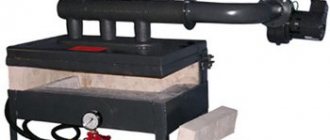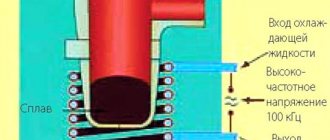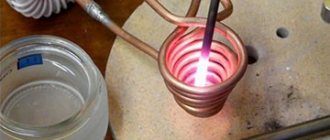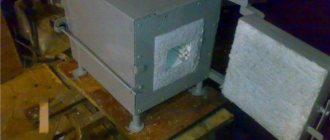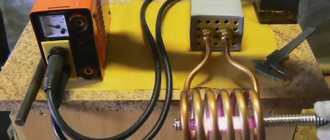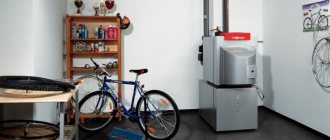This is my homemade smelting furnace, and I also use it as a forge.
To make such a melting furnace with your own hands, you will need the following materials:
- old gas cylinder
- Portland cement
- quartz sand
- wood ash
- perlite (not vermiculite)
- fire-clay
Additional details:
- forge burner
- high gas pressure regulator
- crucible/melting pot/smelter
Tools:
- reciprocating saw (for cutting the cylinder)
- 76mm hole saw (optional)
- 35mm bit for drill
- chisel
- small drill bit
- hacksaw
- drill
How to make high-quality castings
To obtain high-quality bronze casting, subsequent machining of the casting will be required. It is necessary to sequentially perform the operations of separating the sprues, removing flash, mechanical grinding and polishing of the product. It is impossible to immediately obtain a high-quality finished casting at home, so you need to prepare for finishing procedures.
Art bronze casting technology in pictures
Shaft melting furnaces
Shaft smelting furnaces have higher energy efficiency due to better sealing of the furnace from the penetration of atmospheric air and the use of exhaust gases to preheat the aluminum charge.
The aluminum charge passes down the charging shaft and gradually reaches the melting zone, where it is melted by the burners and flows down into the storage tank. Hot exhaust gases pass from the melting zone through the shaft and heat the loaded charge.
Figure 6 – Shaft melting furnace [7]
Advantages of shaft furnaces
- Thanks to preheating of the charge with combustion waste products, energy efficiency reaches 40-50%.
- The finished aluminum melt has a reduced content of hydrogen and non-metallic inclusions. This is achieved by separating the melting zone and the preheating zone. Moisture and other pollutants evaporate or burn while still in the mine, and a dry charge with a minimum of polluting materials enters the melting zone.
- The absence of excessive contact of the melt with atmospheric oxygen, which ensures a reduced level of waste of metallic aluminum (0.8-1.5%).
Disadvantages of shaft furnaces
- In order for shaft furnaces to achieve low levels of waste and high energy efficiency, they must be operated strictly in accordance with the rules established for them, including the use of a sufficiently dense aluminum charge. With a lightweight and thin-walled charge, shaft furnaces may have increased aluminum waste and reduced energy efficiency.
- Shaft furnaces generally have a fairly large height (about 6 m), which is not suitable for all industrial premises.
- The refractory lining at the bottom of the charging well of a shaft furnace is subject to increased mechanical shock loads, which leads to the need for more frequent maintenance.
- Shaft furnaces are more complex to operate than reverberatory furnaces and therefore require additional qualified personnel.
Additional functions of gas furnaces
Each of these three basic oven types may have additional options, as well as elements common to other oven types, such as:
- all three types of furnaces can have external wells for loading crushed charge, for example, shavings, into the melt;
- inclined hearth furnaces and shaft furnaces may have additional loading windows for loading the charge directly into the melt;
- bath furnaces and shaft furnaces can have a wide threshold or a short inclined hearth at the entrance to the furnace for preheating ingots and massive, for example, packaged scrap, as well as for the convenience of removing slag from the surface of the melt;
- All types of furnaces can have a melt mixing system, both in the loading well and in the aluminum melt bath.
Dry hearth reverberatory melting furnaces
In dry hearth furnaces, the loaded aluminum charge is placed on an inclined hearth, which is located above the level of the molten metal (Figure 4). Hot exhaust gases pass through the charge and quickly heat it up. The charge melts and gradually flows from the inclined hearth into a chamber for accumulating molten metal, which is therefore often called a storage tank.
Figure 4 – Reflective melting furnace with a dry hearth. Heated ingots are visible at the entrance to the furnace [5]
Dry hearth ovens are usually used when:
- Most of the loaded aluminum charge is melting ingots, including large ones, that is, the sheet elements have a minimal surface.
- The aluminum charge contains, for example, steel elements, as well as residues from casting molds, such as sand castings. The aluminum part of the charge is melted on an inclined hearth and the aluminum flows down the inclined hearth, and foreign materials remain on the hearth and are removed from the furnace using scrapers.
- The aluminum charge may contain water or be wet.
Advantages of dry hearth furnaces:
- Safety. The entire charge is melted on an inclined hearth, and not under the surface of the melt. Such heating prevents water from entering the melt and the threat of explosion.
- Preventing melt contamination. Allows you to remove foreign, non-aluminum materials from the charge that remain on the inclined hearth.
- Ability to produce large volumes of liquid aluminum almost continuously.
Disadvantages of dry hearth furnaces:
- Typically these stoves have two chimneys, one above the inclined hearth and the other above the boiler. This requires a burner control system for optimal operation [1].
- High loss of aluminum (7-12%) when melting in a furnace atmosphere at a temperature of 700-760 degrees Celsius. Waste is the loss of aluminum metal contained in the loaded charge as a result of its oxidation and transformation into slag.
- Low energy efficiency. The efficiency of furnaces of this type increases with increasing ratio of the volume of the loaded charge to its outer surface. Maximum efficiency is achieved when melting large aluminum ingots, sometimes weighing up to 500 kg [1].
Melting point of copper: how to melt metal at home - step-by-step instructions
Copper is an extremely popular and widespread metal used in the production of electronics, power transmission, and the manufacture of various alloys.
What is the melting point of copper, how is it mined and why is it interesting ? Let's talk about all this.
How is copper obtained?
The reserves of this metal on Earth are relatively small (compared to other elements). Moreover, it is found both in the form of nuggets and as part of complex compounds . Most often these are copper pyrite, chalcopyrite, bornite and chalcocite. They are found in sedimentary rocks, but most often in hydrothermal veins.
